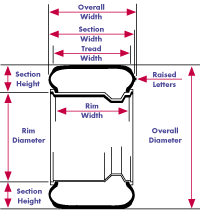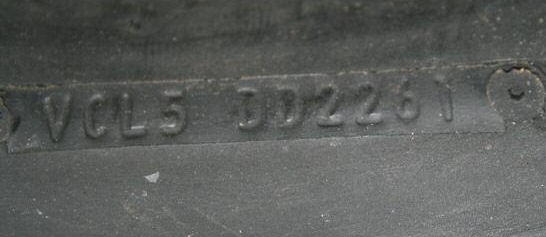Sidewall Markings
There is a lot of information on the sidewall of a tire. Typically, you'll find the Uniform tire Quality Grade (UTQG) ratings for tread wear, traction and temperature, the size of the tire, the load rating index number with a speed rating index, the construction type (bias or radial), the Department of Transportation (D.O.T.) compliance code, construction details, and of course, the make and model of the tire. On some tires used as original equipment, you may also find a marking that indicates its original equipment status such as a General Motors "TPC" code. Light Truck tires are sometimes marked with an LT for "Light Truck" before the size, passenger tires are often marked with the letter P for "Passenger" before the size. Passenger tires of the same size with or without the P are virtually interchangeable.
Modern Tires

UTQG Ratings
The D.O.T. requires each manufacturer to grade its tires under the UTQG labeling system and establish ratings for tread wear, traction, and temperature resistance. These tests are conducted independently by each manufacturer following government guidelines to assign values that represent a comparison between the tested tire and a control tire. While traction and temperature resistance ratings are specific performance levels, the tread wear ratings are assigned by the manufacturers following field testing and are most accurate when comparing tires of the same brand.
Tread Wear
Tread wear receives a comparative rating based on wear rate of the tire in field testing following a government specified course. For example, a tire grade of 150 wears 1.5 times as long as a tire graded 100. Actual performance of the tire can vary significantly depending on conditions, driving habits, care, road characteristics, and climate.
Traction
Straight-a-head wet braking traction has been represented by a grade of A, B, or C with A being the highest. In 1997 a new top rating of "AA" has been introduced to indicate even greater wet braking traction. However, due to its newness, this grade will probably be applied initially to new tire lines as they are introduced and later to existing lines which excel in wet braking, but had been limited to the previous top grade of "A". Traction grades do not indicate wet cornering ability.
Temperature
Temperature resistance is graded A, B or C. It represents the tire's resistance to the heat generated by running at high speed. Grade C is the minimum level of performance for all passenger car tires as set under Federal Motor Vehicle Safety Standards. This grade is established for a tire that is properly inflated and not overloaded.
Note: UTQG ratings are not required on winter and light truck sized tires.
Calculating Tire Dimensions
Modern metric tire dimensions Example...185/60R14 85H or 185/60HR14
The first number is the width of the tire in millimeters, measured from sidewall to sidewall. To convert to inches, divide by 25.4 In the example above, the width is 185mm or 7.28".
The second number is the aspect ratio. This is a ratio of sidewall height to width. In the example above, the tire is 7.28" wide, multiply that by the aspect ratio to find the height of one sidewall. In this case, 185x0.60=111mm or 7.28"x0.60=4.36".
The last number is the diameter of the wheel in inches.
To figure the outside diameter of a tire, take the sidewall height and multiply by 2,(remember that the diameter is made up of 2 sidewalls, the one above the wheel, and the one below the wheel) and add the diameter of the wheel to get your answer.
Example...185/60R14 85H or 185/60HR14
185mm x .60=111mm x 2=222mm + 355.6mm(14")= 577.6mm or 22.74"

Tire Size Conversion Chart
While today's P-metric passenger tire sizes have existed since the early 1980's, restoring classic muscle cars and pony cars has kept yesterday's Numeric and Alpha Numeric tires from disappearing. The chart below is intended to help you determine their equivalent P-metric tire sizes.
Two versions of numeric tire sizes were used as original equipment on vehicles between 1949 and 1970. The early numeric tires had the equivalent of a 90-series aspect ratio, while later tires offered a "lower" profile equivalent to a 80-series. These tires typically featured tread widths ranging from 3.5" for the smallest 13" rim diameter tires to about 5.5" for the largest 15" rim diameter tires.
To convert Numeric sizes to today's P-metric sizes, it is important to remember that early cars were not only equipped with narrow tires, they were equipped with narrow wheels as well. In most cases, numeric tires should be replaced with today's 80- or 75-series sized tires. This is especially important if the original wheels are to be used. Today's lower profile sizes will usually result in too wide a tire with too much gap between the wheel well opening and the top of the tire.
For example: A 1967 Chevelle 7.35-14 would be replaced with a 185R14 or P195/75R14.
Alpha numeric tire sizes were introduced as original equipment in the late 60s and became widely used in the early 70's. These tires were identified with a letter which indicated the tire's load capacity, followed by a "R" if radial ply construction, the tire's aspect ratio and wheel diameter. So while G78-15 (28.01"), G70-15 (27.5") and G60-15 (26.4") sized tires are all rated to carry the same load, their different aspect ratios resulted in tires with the overall diameters indicated above.
To convert Alpha Numeric tires to P-metric sized tires, it is important to identify the original tire's aspect ratio. The 78-series Alpha Numeric tires should be replaced with today's 80-, or 75 series tires. If the vehicle was equipped with the low profile 70-, 60- or 50-series sizes, the P-metric substitution should be selected from the P-metric size column that offers the equivalent aspect ratio as the existing tire.
| 1949 to 1964 | 1965 to 1970 | 1970 to 1980 | 1980 - On | |||||
| NUMERIC | ALPHA NUMERIC | EUROMETRIC | P-METRIC | EUROMETRIC or P-METRIC | ||||
| "90" to "80"-Series | 78 to 50-Series | "82"-Series | 80-, 75-series | 70-series | 65-series | 60-series | 50-series | |
| 145R10 | 165/70R10 | |||||||
| 145R12 | P145/80R12 | 165/70R12 | ||||||
| 6.00-12 | 155R12 | P155/80R12 | ||||||
| 165/65R13 | ||||||||
| 145R13 | ||||||||
| 155R13 | P155/80R13 | 175/70R13 | 195/60R13 | 215/50R13 | ||||
| 5.60-13 | 6.00-13 | A | 165R13 | P165/80R13 | 185/70R13 | 205/60R13 | ||
| 6.50-13 | B | 175R13 | P175/80R13 | |||||
| C | P185/80R13 | |||||||
| 7.00-13 | D | 185R13 | ||||||
| 195R13 | ||||||||
| 175/65R14 | ||||||||
| 6.00-14 | 6.45-14 | 155R14 | 175/70R14 | 185/65R14 | ||||
| B | 165R14 | P175/75R14 | 185/70R14 | 195/65R14 | 205/60R14 | |||
| 6.50-14 | 6.95-14 | C | 175R14 | P185/75R14 | 195/70R14 | 215/60R14 | ||
| D | ||||||||
| 7.00-14 | 7.35-14 | E | 185R14 | P195/75R14 | 205/70R14 | 225/60R14 | 245/50R14 | |
| 7.50-14 | 7.75-14 | F | 195R14 | P205/75R14 | 215/70R14 | 235/60R14 | ||
| 8.00-14 | 8.25-14 | G | 205R14 | P215/75R14 | 225/70R14 | 245/60R14 | 265/50R14 | |
| 8.50-14 | 8.55-14 | H | 215R14 | P225/75R14 | ||||
| 9.00-14 | J | 225R14 | ||||||
| 9.50-14 | L | |||||||
| 5.60-15 | A | 155R15 | P155/80R15 | 185/65R15 | 195/60R15 | |||
| 6.00-15 | B | 165R15 | P165/80R15 | 185/70R15 | 195/65R15 | 205/60R15 | 225/50R15 | |
| 6.50-15 | 6.85-15 | C | 175R15 | 195/70R15 | 205/65R15 | 215/60R15 | ||
| D | ||||||||
| 7.35-15 | E | 185R15 | P195/75R15 | 205/70R15 | 215/65R15 | 225/60R15 | ||
| 6.70-15 | 7.75-15 | F | 195R15 | P205/75R15 | 215/70R15 | 235/60R15 | ||
| 8.15-15 | ||||||||
| 7.10-15 | G | 205R15 | P215/75R15 | 225/70R15 | 235/65R15 | 245/60R15 | 265/50R15 | |
| 8.25-15 | ||||||||
| 8.45-15 | ||||||||
| 7.60-15 | H | 215R15 | P225/75R15 | 235/70R15 | 255/60R15 | 275/50R15 | ||
| 8.55-15 | ||||||||
| 8.00-15 | 8.85-15 | J | 225R15 | P225/75R15 | 235/70R15 | 265/60R15 | ||
| 8.20-15 | 9.00-15 | K | ||||||
| 9.15-15 | L | 235R15 | P235/75R15 | 255/70R15 | 275/60R15 | 295/50R15 | ||
| N | 305/50R15 | |||||||
| Listing in chart does not imply complete interchangeability. | When changing tire sizes, dimensional clearances must be checked. | |||||||
Each row of the above chart is roughly the same diameter tires, but the width varies by column, and the diameters are not exact matches.
Diameter Comparison
While this chart certainly doesn't guarantee a specific tire will fit your vehicle, it can give you an idea of the tire sizes with the same diameter.
| Approx. Tire Diameter | P-metric and European Metric | LT-metric | Light Truck | Light Truck | |||
| (in Inches) | 75-series and Higher | 70- and 65-series | 60-series and Lower | 85-series | 75-series and Lower | Flotation | Numeric |
| 34 1/2 | 35X12.50R15LT | ||||||
| 33 1/2 | LT255/85R16 | ||||||
| 33 | LT285/75R16 | ||||||
| 32 1/2 | 33X12.50R16.5LT | ||||||
| 33X12.50R15LT | |||||||
| 31 1/2 | P275/70R16 | LT235/85R16 | LT265/75R16 | 32X11.50R15LT | 7.50R16 | ||
| 30 1/2 | P265/75R15 | 265/70R16 | 285/60R17 | LT215/85R16 | LT285/60R17 | 31X10.50R16.5LT | 9.50R16.5LT |
| LT245/75R16 | 31X11.50R15LT | ||||||
| LT325/60R15 | 31X10.50R15LT | ||||||
| 30 | P255/70R16 | P275/60R17 | |||||
| 29 1/2 | P245/70R16 | 265/60R17 | LT225/75R16 | 30X9.50R15LT | 8.75R16.5LT | ||
| 7.00R15 | |||||||
| 29 | 205R16 | 255/65R16 | 255/55R18 | LT235/75R15 | |||
| 205/80R16 | P235/70R16 | 255/60R17 | |||||
| P235/75R15 | P255/70R15 | ||||||
| 28 1/2 | P225/75R15 | P225/70R16 | LT225/75R15 | 29X9.50R15LT | 8.00R16.5LT | ||
| P245/70R15 | |||||||
| 28 | 215/70R16 | P255/55R17 P275/60R15 | |||||
| 27 1/2 | P215/75R15 | P225/70R15 | LT215/75R15 | ||||
| 27 | P205/75R15 | P215/65R16 | 255/50R17 | LT205/75R15 | |||
| P305/50R15 | |||||||
| P255/60R15 | |||||||
| 26 1/2 | P195/75R15 | P225/70R14 | P295/50R15 | LT195/75R15 | 27X8.50R14LT | ||
| P245/60R15 | |||||||
| 26 | P205/75R14 | P215/65R15 | P235/60R15 | ||||
| 185R14 | P215/70R14 | ||||||
| 25 1/2 | P195/75R14 | P205/70R14 | P225/60R15 | ||||
P-Metric and Euro Metric Sizing
What's the difference between the tire sizes of P225/60R16 and 225/60R16? The obvious answer is the "P" in front of the first size, but just what does the "P" stand for and what does it tell us about the tires?
P-metric sized tires are the ones with the "P" at the beginning of the tire size (such as P225/60R16 listed above). They were introduced in the United States in the late 70s and are installed on vehicles primarily used to carry passengers including cars, station wagons, sport utility vehicles and even light duty pickup trucks. Their load capacity is based on an engineering formula which takes into account their physical size (the volume of space for air inside the tire) and the amount of air pressure (how tightly the air molecules are compressed). Since all P-metric sizes are all based on the formula for load, vehicle manufacturers can design their new vehicles (weights and wheel well dimensions) around either existing or new tire sizes.
Metric or Euro metric sized tires are the ones without the "P" at the beginning (such as 185R14 or the 225/60R16 listed above). Using metric dimensions to reflect a tire's width actually began in Europe in the late 60s. However, since Euro metric sizes have been added over time based on the load and dimensional requirements of new vehicles, the tire manufacturers designed many new tire sizes and load capacities around the needs of new vehicles. Not quite as uniform as creating sizes using a formula, but they got the job done.
Euro metric and P-metric tires in the same size (i.e. P225/60R16 & 225/60R16) are equivalent in their dimensions with just slight differences in their load capacity calculations and inflation pressure tables. So if Euro metric and P-metric tires have the same numeric size, the same tire performance category and the same speed rating, the two are considered equivalent and interchangeable if used in axle pairs or sets of four. Simply continue to follow your vehicle manufacturer's recommended inflation pressures provided in the vehicle's owner's manual or on the vehicle tire placard (usually found on the door jamb or on the glove box or console door) for either size tire.
D.O.T. Number
The D.O.T. identification can help determine when a particular tire was manufactured. A typical identification might look like VCL5DD2261 for a typical pre-1999 tire. VC is the manufacturing plant code, L5DD2 is internal production information for the manufacturer, and 261 is the week (26) and year (1971) of production.

A typical tire from 2000 and later would have something like GJHV232001 where the last 4 digits represent the week (20) and the year (01).
© GEN 2 CAMAROWORLD 1970-1973
 1970
1970 1971
1971 1972
1972 1973
1973

